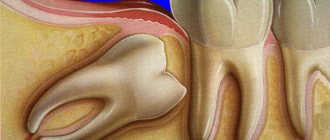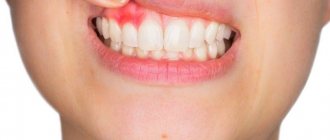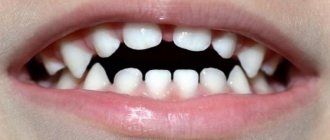How to remove cheek swelling from a tooth.
Swelling of the cheek can be the result of a great variety of reasons, of which there are more than a dozen, and inflammation, as a result of which the swelling is formed, can be both in the gums and periosteum, and in the salivary glands near the cheek.
Today we will try to find out how to remove cheek swelling from a tooth.
When we say “from a tooth,” we mean that a tumor on the cheek appears as a result of some kind of dental disease. Among these are:
- deep dental caries, which caused inflammation of the gums, and then the mucous membrane of the cheek;
- periostitis (flux), which, being an inflammation of the periosteum, spreads the inflammatory process to the gums, and then can spread to the cheek;
- tooth extraction can also cause the development of inflammatory processes in the oral cavity.
There may be several reasons for cheek swelling, but it is always an inflammatory process
If swelling and pain increase, you should consult a dentist as soon as possible. After examining the oral cavity and making a diagnosis, the doctor will prescribe treatment and recommend how to remove the tumor from the cheek most effectively.
How to remove swelling when your cheek is swollen from a tooth? This depends on the location of the tooth, the direction in the development of the inflammatory process, as well as its intensity and form of occurrence.
As a rule, antibiotic therapy is carried out first, both general with tablets and local with gels and antiseptic sprays.
However, before embarking on any treatment, it is necessary to confirm the diagnosis with a specialist and listen to his recommendations as to whether it is necessary to remove the tooth that caused inflammation of the mucous membrane or whether it is possible to get by with eliminating the inflammation and treating the disease that caused it.
How do you remove a tumor when your tooth hurts and your cheek is swollen? And is it necessary to remove the tooth? Usually, they try to cure a diseased tooth rather than pull it out, so tooth extraction is resorted to only if there is a real threat of blood poisoning.
In other cases, the doctor carries out an antiseptic treatment of the mucous membrane, opens the purulent source of inflammation and draws out the pus through drainage devices.
Dental treatment
If the dentist does not treat the tooth correctly or completely, it can cause swelling in the cheek.
Causes:
- Allergic reaction.
It appears in the patient as a result of intolerance to the components of the filling. To eliminate swelling, you should visit a doctor and replace the installed filling with a hypoallergenic one.
- Removal of a tooth.
If the cheek is swollen after surgery, then the patient probably ignored the doctor’s recommendations and ate solid or hot foods.
- Nerve removal.
Swelling occurs if part of the nerve is not removed. It is important to see a dentist immediately so as not to lose a healthy tooth.
- Gum section.
Usually required to remove accumulated pus. If the swelling does not subside while taking anti-inflammatory drugs, this may be a serious symptom that requires the attention of a specialist.
Other provocateurs
In addition to diseases and pathological changes that cause swelling of the cheek from the tooth, there are a number of other causes.
If an infection enters the patient’s body, medications that have an antibacterial effect should be taken. Thanks to this, you will get rid of the main cause, that is, infection, and the consequence - swelling. With inflammation of the lymph nodes in children, this situation often occurs.
The presence of a sebaceous gland cyst provokes changes in the facial part. In this case, surgical intervention will be required.
The cause is identified as neurological diseases. In addition to swelling of the cheek, the patient may suffer from congestion in the ear canal and discomfort in the throat area. To find out the reasons, you need to consult a neurologist.
A similar situation occurs with injuries or bruises. You can reduce the size of swelling by using a cold compress.
With a pathological change in the condition of the internal organs, swelling of the cheek is observed. To find out the reasons, you should consult your doctor.
It is important to know what to do if your cheek is swollen. Here are some tips to help reduce unpleasant symptoms:
- Often, after you have a wisdom tooth pulled out, you may experience swelling. To get rid of this, you should rinse your mouth with chamomile or sage. Chlorhexidine is perfect for these purposes.
- A fairly effective remedy is a saline (soda) solution. Rinsing with these products relieves pain and produces an antiseptic effect.
- While a wisdom tooth is coming out, it is worth using the help of special ointments and creams. Their use helps to minimize unpleasant symptoms.
- If your cheek is swollen after a wisdom tooth has been pulled out, you should use Kalanchoe or aloe juice. To do this, soak a cotton pad in the medicine, then apply it to the painful area.
- This manifestation is also possible with an insect bite. In this case, a decoction of chamomile, combined with aloe, helps.
Experts advise taking vitamin complexes daily to help improve the protective function of the immune system. It is better to reconsider your diet, in particular this concerns reducing the consumption of sweets. You can perform a light gum massage for preventive purposes.
By following basic rules of personal hygiene and regularly visiting the dentist, you will prevent complications and the development of pathological conditions.
Dental disease and its treatment is an unpleasant phenomenon that many adult men and women try to avoid or delay until an emergency. But the most dangerous thing about far-fetched fear is that while a person waits for the disease to become unbearable, destruction of teeth and gums occurs, which in the initial stages could be treated with fairly simple, almost painless and inexpensive methods. In this article we will talk about gumboil, how to get rid of it, and how to help the patient at home.
What to do if your cheek is swollen
To reduce swelling, you can use one of the following tips:
- Rinse your mouth with a solution of salt and soda.
This remedy has an antiseptic effect and helps destroy pathogens. You can enhance the effect by adding a couple of drops of iodine to the solution.
- Use chamomile infusion to rinse
, sage or other medicinal herbs that have anti-inflammatory properties.
- Apply a cold compress to the swollen cheek
if the swelling is caused by a bite or mechanical injury. This method is contraindicated in patients who have an elevated body temperature or a tumor that develops due to inflammatory processes. Warming compresses are not recommended.
- Lotions with aloe or Kalanchoe juice.
A cotton wool soaked in the juice of the plant is applied to the inside of the affected cheek.
If the described methods do not eliminate the problem, you should seek help from a doctor. The day before, you should not take painkillers and anti-inflammatory drugs, so as not to complicate the diagnosis.
What are the main causes of swelling with pain?
The main cause is inflammatory processes of periodontal tissues, which are caused by a number of pathological conditions.
- Advanced caries, bad habits, ignoring hygiene rules or poor-quality root canal filling. In most cases, swelling of the cheek is preceded by pain localized on the side of the affected tooth. The source of inflammation is located in the root area and after a few days a flux can form, which without treatment transforms into an abscess.
- Very often, swelling of the cheek occurs due to disruption of the eruption of wisdom teeth. In this case, purulent inflammation is caused by the formation of a pocket (hood) between the gum and the dental unit itself. In addition, due to lack of space in the jaw arch, molars can occupy an unphysiological position and injure the buccal mucosa.
- Inflammation caused by infection of the socket after the removal of a molar very often leads not only to swelling of the cheek, but also to more serious consequences.
- A dental cyst is characterized by asymptomatic formation over a long period of time; when it increases to 5-7 mm, the neoplasm presses on the bone. The pathology is characterized by acute throbbing pain, accompanied by swelling and redness of the gums, as well as deterioration of the general condition.
The danger of inflammatory processes in the oral cavity lies in the close proximity of pathogenic swelling to the tissues of the face and brain. If left untreated, there is a high risk of phlegmon and abscess formation, which in extreme situations can lead to death.
How to treat
If it is not possible to immediately seek medical help, but the tumor still causes discomfort and bothers you, folk remedies will help improve your condition:
- Kalanchoe. Soak a cotton swab in freshly squeezed juice of a houseplant and apply it to the inside of your cheek for 30-40 minutes. During the day, the procedure can be repeated up to 4 times.
- Aloe. The plant juice is used in the same way as the previous recipe.
- Salt and baking soda. Dissolve 0.5 tsp in a glass of warm boiled water. these funds. Rinse your mouth with the resulting solution every 2-3 hours.
- Calendula. Prepare an infusion: pour boiling water (0.75 l) over 3 flowers, leave for 2 hours and rinse your mouth as often as possible. An alternative to calendula can be an infusion with St. John's wort (2 tablespoons of the plant per 1 tablespoon of boiling water).
- Sage and chamomile. Their decoction is used to rinse after every meal. Prepared: 1 tbsp. l. Pour 250 ml of boiling water over each plant, leave for 3 hours, strain.
- Propolis. If the inflammation is local, it is recommended to cover the affected area with propolis and hold it for at least an hour.
- Iodine. Dilute 5 drops of the drug in 200 ml of water, add 1 tsp. salt and stir well. Rinse your mouth with the solution every 2-3 hours.
- Collection of medicinal herbs. 10 g of yarrow, 10 g of oak bark, 5 g of sage, pour 200 ml of boiling water, leave for 1 hour, strain. Use the prepared infusion to rinse your mouth throughout the day.
Important: all of the recipes listed will help reduce swelling and relieve pain, but they are not able to eliminate the cause itself. All these remedies can only be used as adjuvant therapy.
Only a qualified specialist can identify the exact cause of gum changes and prescribe appropriate treatment. If there are no serious diseases associated with the functioning of internal organs and their systems, then first of all, drugs that relieve tumors are prescribed.
If swelling is accompanied by active inflammation, it is recommended to take an anti-inflammatory drug, for example, Nimesil. To relieve pain, one of the anesthetics may be prescribed: Ibuprofen, Ketorol, Ketanov.
If the pathology was caused by an allergic reaction, then antihistamines are used in treatment: Suprastin, Erius, Tavegil, Diazolin. To treat the mouth, antiseptics are prescribed in the form of Miramistin and Chlorhexidine solutions.
In difficult cases, antibiotics (usually the penicillin group) are prescribed, which in a short period of time stabilize the condition, relieve pain and return the face to its previous appearance: “Amoxiclav”, “Biseptol”, “Lincomycin”.
We know what to do when teeth become loose. You can read a useful article on the next page. From the published review: https://dentist-pro.ru/lechenie/zuby/kista/kakie-simptomy-svidetelstvuyut.html - you can learn about the symptoms of a dental cyst.
And here is information about what red spots on the tongue of an adult can mean.
Prevention Tips
We have figured out how to remove swelling, and now let’s talk about how to prevent the development of swelling. In this regard, it is important to ensure proper care and prevention of dental diseases, and for this it is enough to adhere to these simple rules:
- the diet should include foods rich in beneficial vitamins and minerals - this is necessary to maintain the natural functioning of all internal systems of the body,
- You need to visit the dentist’s office at least once every six months for preventive examinations,
- If any suspicious dental symptoms appear, you should immediately consult a doctor,
- In your arsenal for carrying out daily hygiene procedures, it would not be amiss to include such tools and devices as an irrigator, dental floss and mouth rinse,
- It is periodically necessary to undergo a hygienic cleaning procedure to remove plaque and dental deposits in the dentist’s office.
Preventative dental examinations will help avoid the problem.
Swelling of the gum tissue and cheeks is a symptom that requires immediate medical intervention. Such a pathological manifestation often indicates serious problems in the body, so the sooner you seek professional help, the lower the risk of developing complications in the future.
- Vladychenkova N.D. Analysis of medical errors and complications in the treatment of dental patients, 2010.
Tip #5: Avoid activities that cause blood flow to the head
Blood rushing to the soft tissues in the facial area increases pressure on the sore area, increases discomfort, increases swelling, and increases the spread of bacteria. To make the swelling of the cheek less significant and painful, we will tell you how to act. Of course, it will not be possible to remove it completely, but it will be possible to reduce the intensity of the unpleasant sensations.
First, temporarily exclude from your diet foods that increase blood circulation: hard and hot, spicy and salty foods. Avoid drinking caffeinated and alcoholic drinks. Try not to drink too much, because... this provokes internal swelling of the tissues. You should also chew food on the side of the jaw that is opposite to the swollen side, so as not to further injure the tissue.
Avoiding coffee helps reduce swelling
Secondly, try to keep your head upright. To do this, use a high pillow when sleeping or resting.
Thirdly, reduce physical activity and avoid sports while swelling of the cheek is present. Also avoid visiting saunas and steam rooms, beaches (on hot sunny days), and do not take a hot bath. And, of course, give up such a bad habit as smoking.
Notice
: Undefined variable: post_id in
/home/c/ch75405/public_html/wp-content/themes/UltraSmile/single-item.php
on line
45 Notice
: Undefined variable: full in
/home/c/ch75405/public_html/wp-content /themes/UltraSmile/single-item.php
on line
46
Rate this article:
( 4 ratings, average: 5.00 out of 5)
toothache
- Minaeva N.V. Modern strategy for antibacterial therapy of upper respiratory tract infections in children in outpatient practice / Medical Council. – 2022.
Expert “Before treating or removing a tooth, or any other surgical procedure, an experienced dentist must find out whether the patient has diseases or allergic reactions to medications that can lead to swelling. If a person suffers from hypertension (high blood pressure) or has problems with blood clotting, then the likelihood of developing edema increases sharply. The doctor’s task is not only to warn the patient about possible consequences, but also to minimize the risk of their occurrence with the help of supportive drug therapy.” Dental hygienist Victoria Nikolaevna Kashaeva
Consulting specialist
Kashaeva Victoria Nikolaevna
Specialization: Dental hygienist Experience: 8 years
What does flux look like?
It is of infectious origin, the process occurs against the background of inflammation of the body of the jaw or in the periosteum. Flux is formed not only after dental surgery, but also after furunculosis or tonsillitis. If the cheek and gums are swollen, there is throbbing or mild pain, in advanced stages pus may appear and the temperature may rise. On the upper jaw, the flux covers the lip, cheek, gum and nasolabial area. In addition to the face, the infection often spreads to the neck.
Anti-inflammatory and antibacterial drugs are used for treatment. After using topical medications, you should not eat or drink liquids for 2 hours.
Reviews
Swelling of the gums is an unpleasant and very serious problem that can only be solved with medical help. Even if the tooth does not cause concern, treatment cannot be neglected. By consulting a doctor in a timely manner, you can not only quickly deal with the tumor, but also prevent the development of severe complications.
You can share your experience in treating this pathology and express your opinion on the effectiveness of various methods by leaving a comment on this article.
If you find an error, please select a piece of text and press Ctrl+Enter.











